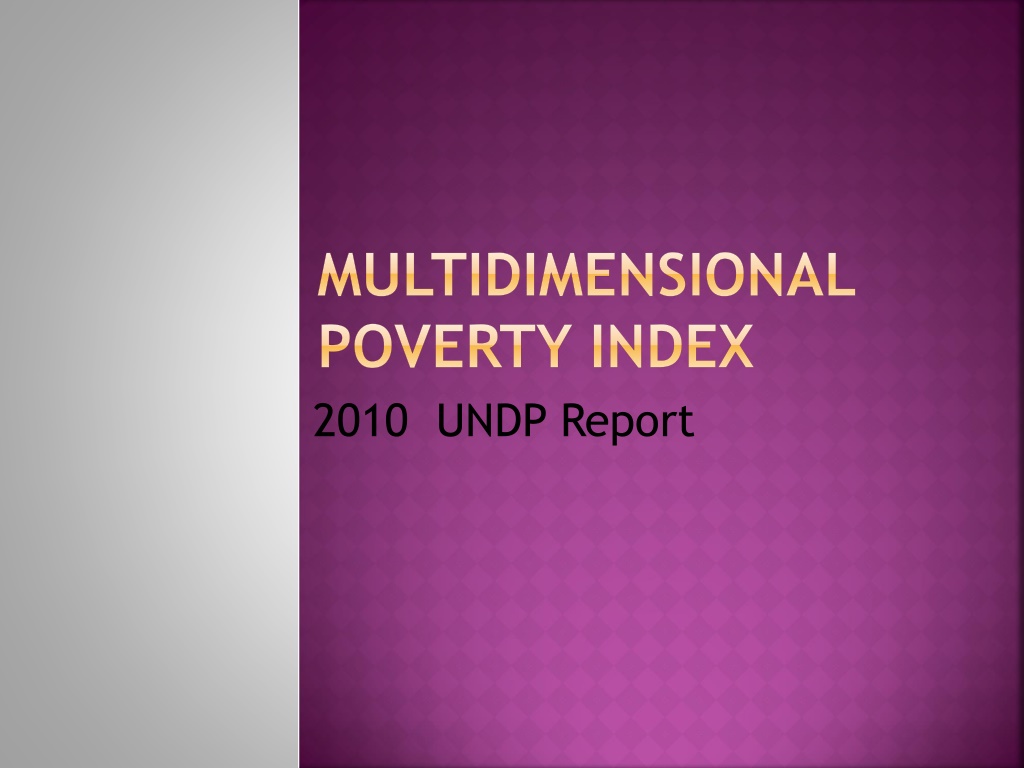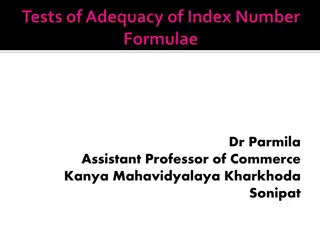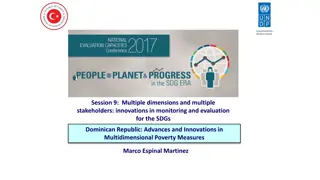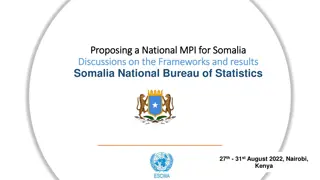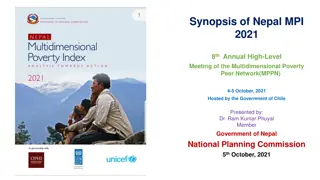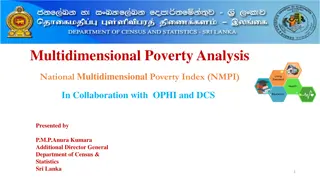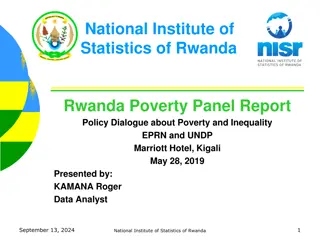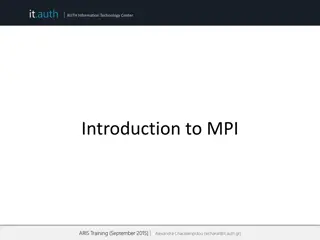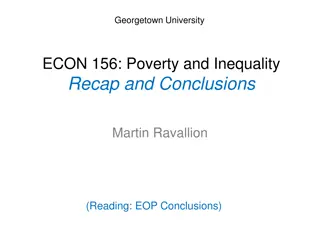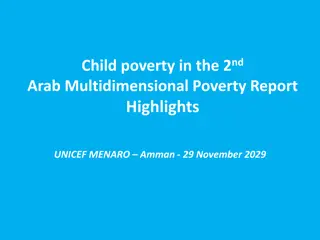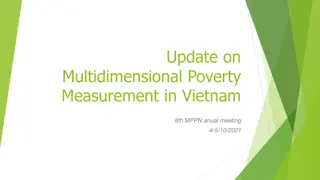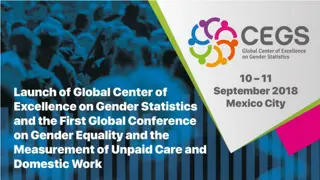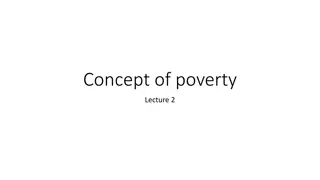Understanding the Multidimensional Poverty Index (MPI)
The MPI, introduced in 2010 by OPHI and UNDP, offers a comprehensive view of poverty by considering various dimensions beyond just income. Unlike traditional measures, the MPI captures deprivations in fundamental services and human functioning. It addresses the limitations of monetary poverty measures, revealing a nuanced picture of poverty that can guide more effective resource allocation for development. By incorporating indicators linked to the MDGs and emphasizing the household as the base population, the MPI highlights interconnections among deprivations across different dimensions.
Download Presentation

Please find below an Image/Link to download the presentation.
The content on the website is provided AS IS for your information and personal use only. It may not be sold, licensed, or shared on other websites without obtaining consent from the author. Download presentation by click this link. If you encounter any issues during the download, it is possible that the publisher has removed the file from their server.
E N D
Presentation Transcript
MULTIDIMENSIONAL POVERTY INDEX 2010 UNDP Report
The Initiative (OPHI) of Oxford University and the Human Development Report Office of the United Nations Development Programme (UNDP) launched in July 2010 a new poverty measure that gives a multidimensional picture of people living in poverty which its creators say could help target development resources more effectively. Oxford Poverty and Human Development The MPI supplants the Human Poverty Index, which had been included Development Reports since 1997. in the annual Human
Unlike the MPI, however, the international MDG reports invariably report indicator singly. No composite MDG index has been developed, and few studies have reflected the interconnections between indicators. progress on each The denominator or base population of MDG indicators differ. In some cases it is all people (malnutrition, income); in some cases children (primary school, immunization), or youth 15-24 (literacy), or childbearing mortality), or urban slum dwellers (housing), or households (access to secure tenure), and so on. Some environmental indicators do not refer to human populations at all. women (maternal
Given this diversity of indicators, it is difficult to construct an index that meaningfully brings all deprivations into the same frame. MPI reflects deprivations in very rudimentary services and core human functionings . MPI reveals a different pattern of poverty than income poverty.
WHY DO WE NEED MULTIDIMENSIONAL MEASURES Monetary poverty often provides insufficient policy guidance regarding deprivations in other dimensions. Ruggeri-Laderchi, Saith, observed that in India, 43 percent of children and more than half of adults who were capability poor (using education or health as the indicator) were not in monetary poverty; similarly, more than half of the nutrition-poor monetary poverty. Monetary poverty thus appears to significantly misidentify deprivations in other dimensions. and Stewart (2003) children were not in
WHAT THE MPI DOES IN RELATION TO THE MDGS First, it employs indicators that relate to the MDGs: 8 of the 10 indicators are directly linked to MDGs. Second, the MPI establishes the base population as being the household. People live in households, the suffering of one members, and similarly the abilities of one member (e.g. literacy) household members. member affects other often help other
WHAT IS THE MPI? The lives of people living in poverty are affected by more than just Multidimensional Poverty Index (MPI) reflect the deprivations that a poor person faces all at once with respect to education, health and living standard. It assesses poverty at the individual level, with poor persons being those deprived, and the extent of their poverty being measured by the range of their deprivations. their income. The who are multiply
The MPI can be used to create a vivid picture of people living in poverty, both across countries, regions and the world and within countries by ethnic group, urban/rural location, or other key household characteristics. The MPI can be used as an analytical tool to identify the most vulnerable aspects in which they are deprived and help to reveal the interconnections among deprivations. This enables policy makers to target resources and design policies more dimensions of interest, such as work, safety, and empowerment, could be incorporated into the MPI in the future as data become available. people, show effectively. Other
WHAT DOES THE MPI MEASURE The MPI uses 10 indicators to measure three critical dimensions of poverty at the household level: education, health and living standard in 104 developing countries. These directly measured deprivations in health and educational outcomes services such as water, electricity reveal not only how many people are poor but also the composition of their poverty. The MPI also reflects the intensity of poverty the sum of weighted deprivations that each household faces at the same time. A person who is deprived in 70% of the indicators is clearly worse off than someone who is deprived in 40% of the indicators. as sanitation, well as key and
WHY IS THE MPI USEFUL Show someone s life at the same time so it can inform a holistic response. all the deprivations that impact Identify the poorest people. Such information is vital to target people living in poverty so they benefit from key interventions. Show which deprivations are most common in different regions and among different groups, so that resources can be allocated and policies designed to address their particular needs.
Reflect interventions measures immediately reflect changes such as school enrolment, whereas it can take time for this to affect income. Integrate many different aspects of poverty related to the MDGs into a single measure, reflecting interconnections deprivations and helping to identify poverty traps. the results quickly. outcomes of effective Because directly, policy MPI will the it among
HOW WAS THE MPI CREATED The developed by Sabina Alkire and James Foster. The Alkire Foster method measures outcomes at the individual level (person or household) against multiple criteria indicators). The method is flexible and can be used with different dimensions and indicators to create measures specific to different societies and situations. MPI was created using a technique (dimensions and
It can be applied to measure poverty or wellbeing, target services or conditional cash transfers and for monitoring and evaluation of programmes. The intensity and depth of poverty, as well as inequality among the poor, depending on the type of data available to create the measure. Read our policy page for more information on the method and the countries that have adopted it. method can show the incidence,
The education, and standard of living. These are measured using ten indicators. MPI has three dimensions: health, The MPI reveals the combination of deprivations that batter a household at the same time. A household is identified as multidimensionally poor if, and only if, it is deprived in some combination of indicators whose weighted sum exceeds 30 percent of deprivations.
1. HEALTH (EACH INDICATOR WEIGHTED EQUALLY AT 1/6) Child Mortality: If any child has died in the family Nutrition: If any adult or child in the family is malnourished
2. EDUCATION (EACH INDICATOR WEIGHTED EQUALLY AT 1/6 ) Years of Schooling If no household member has completed 5 years of schooling Child Enrolment If any school-aged child is out of school in years 1 to 8
3. STANDARD OF LIVING (EACH OF THE SIX INDICATORS WEIGHTED EQUALLY AT 1/18) Electricity If household does not have electricity Drinking water If does not meet MDG definitions, or is more than 30 mins walk Sanitation If does not meet MDG definitions, or the toilet is shared Flooring If the floor is dirt, sand, or dung Cooking Fuel If they cook with wood, charcoal, or dung Assets If do not own more than one of: radio, tv, telephone, bike, motorbike
3. STANDARD OF LIVING (EACH OF THE SIX INDICATORS WEIGHTED EQUALLY AT 1/18) Electricity If household does not have electricity Drinking water If does not meet MDG definitions, or is more than 30 mins walk Sanitation If does not meet MDG definitions, or the toilet is shared Flooring If the floor is dirt, sand, or dung Cooking Fuel If they cook with wood, charcoal, or dung Assets If do not own more than one of: radio, tv, telephone, bike, motorbike
HOW TO APPLY THE ALKIRE FOSTER METHOD 12 Steps to a Multidimensional 12 Steps to a Multidimensional Poverty Measure: Poverty Measure: Step 1: Choose Unit of Analysis. The unit of analysis is most commonly an individual or household but could also be a community, school, clinic, firm, district, or other unit.
Step 2: Choose Dimensions. The choice of dimensions is important but less haphazard than people assume. In practice, most researchers implicitly draw on five means of selection, either alone or in combination:
Ongoing deliberative participatory exercises that elicit the values and perspectives of stakeholders. A variation of this method is to use survey data on people s perceived necessities. A list that has achieved a degree of legitimacy through public consensus, such as the universal declaration of human rights, the MDGs, or similar lists at national and local levels. Implicit or explicit assumptions about what people do value or should value. At times these assumptions are the informed guesses of the researcher; in other situations they are drawn from convention, social or psychological theory, or philosophy. Convenience or a convention that is taken to be authoritative or used because these are the only data available that have the required characteristics. Empirical evidence regarding people s values, data on consumer preferences and behaviours, or studies of what values are most conducive to people s mental health or social benefit. Clearly these processes overlap and are often used in tandem empirically; for example, nearly all exercises need to consider data availability or data issues, and often participation, or at least consensus, is required to give the dimensions public legitimacy.
Step 3: Choose Indicators. Indicators are chosen for each dimension on the principles of accuracy (using as necessary so that analysis can properly guide policy) and parsimony (using as few indicators as possible to ensure ease of analysis for policy purposes and transparency). Statistical properties are often relevant for example, when possible and reasonable, it is best to choose indicators that correlated. many indicators as are not highly
Step 4: Set Poverty Lines. A poverty cutoff is set for each dimension. This step establishes the first cutoff in the methodology. Every person can then be identified as deprived or nondeprived with respect to each dimension. For example, if the dimension is schooling ( How many years of schooling have you completed? ), 6 years identify nondeprivation, while 1 5 years might identify deprivation in the dimension. Poverty thresholds robustness, or multiple sets of thresholds can be used to clarify categories of the poor (such as poor and extremely poor). or more might can be tested for explicitly different
Step 5: Apply Poverty Lines. This step replaces the person s achievement with his or her status with respect example, in the dimension of health, when the indicators are access to health clinic and self-reported morbidity body mass index, people are identified as being deprived or nondeprived for each indicator. to each cutoff; for
Step 6: Count the Number of Deprivations for Each Person. This step is demonstrated in the last column of Table 1. (Equal weights among indicators are assumed for simplicity. General weights can be applied, however, in which case the weighted sum is calculated.)
Step 7: Set the Second Cutoff. Assuming equal weights for simplicity, identification cutoff, number of dimensions in which a person must be deprived in order multidimensionally poor. In practice, it may be useful to calculate the measure for several values of k. Robustness performed across all values of k. In the example in Table 1, k is set to 4 and the persons whose data are shaded are identified as poor. set which a second k, gives the to be considered checks can be
Step 8: Apply Cutoff k to Obtain the Set of Poor Persons and Censor All Nonpoor Data. The focus is now on the profile of the poor and the dimensions in which they are deprived. All information on the nonpoor is replaced with zeros (0). This step is shown in Table 2.
Step 9: Calculate the Headcount, H. Divide the number of poor people by the total number of people. In our example, when k = 4, the headcount is merely the proportion of people who are poor in at least 4 of d dimensions. For example, as seen in Tables 1 and 2, two of the four people were identified as poor, so H = 2/4 = 50 per cent. The multidimensional headcount is a useful measure, but it does not increase if poor people become more deprived, nor can it be broken down by dimension to analyze how poverty differs among groups. For that reason we need a different set of measures.
Step 10: Calculate the Average Poverty Gap, A. A is the average number of deprivations a poor person suffers. It is calculated by adding up the proportion of total deprivations each person suffers (for example, in Table 2, Person 1 suffers 4 out of 6 deprivations and Person 4 suffers 6 out of 6) and dividing by the total number of poor persons. A = (4/6 + 6/6)/2 = 5/6.
Step 11: Calculate the Adjusted Headcount, M0. If the data are binary or ordinal, multidimensional poverty is measured by the adjusted headcount, M0, which is calculated as H times A. Headcount multiplied by the dimensions in which all poor people are deprived to reflect deprivations. In our example, HA = 2/4 5/6 = 5/12. poverty number is of average the breadth of
Step 12: Decompose by Group and Break Down by Dimension. The adjusted headcount M0 can be decomposed by population subgroup (such as region, rural/ urban, constructing M0 for each subgroup of the sample, we can break M0 apart to study the contribution of each dimension to overall poverty. or ethnicity). After
ALKIRE FOSTER METHOD Contemporary poverty generate a statistic for the percentage of the population who are poor, a head count (H). The Alkire Foster Method generates a headcount and also a unique class of poverty measures (M ): methods wellbeing of measuring commonly and
M0 An adjusted head count. This reflects both the incidence (the percentage of the population who are poor) and intensity of poverty (the number of deprivations suffered by each household, A). It is calculated by multiplying the proportion of people who are poor by the average number of their deprivations (M0 = H x A).
M1 This measure reflects the incidence, intensity and depth of poverty. The depth of poverty is the gap (G) between poverty and the poverty line (M1 = H x A x G). M2 This measures reflects the incidence, intensity, depth of poverty and inequality among the poor (the squared gap, S) (M2 = H x A x S).
M0 can be calculated with ordinal and cardinal data. Cardinal data are required to calculate M1 and M2. The Alkire Foster Method is unique in that it can distinguish between, for example, a group of poor people who suffer only one deprivation on average and a group of poor people who suffer three deprivations on average at the same time. This flexible approach can be employed in a variety of situations by choosing different dimensions (e.g. education), indicators (e.g. how many years of education a person has) and cutoffs (e.g. a person with fewer than five considered deprived). years of education is
COMMON USES OF THE ALKIRE FOSTER METHOD Poverty measures. The Alkire Foster method can be used to create international measures of poverty or wellbeing by incorporating dimensions and indicators that are tailored to the specific context. Targeting of services or conditional cash transfers. The Alkire Foster method can be used to target people who meet multiple criteria. Monitoring and evaluation. method can be used to monitor the effectiveness of programmes over time. national, regional or The Alkire Foster
WHY USE A MULTIDIMENSIONAL APPROACH Income alone can miss economic growth has been strong in India in recent years. In contrast, the malnutrition has remained at nearly 50 per cent, which is among the highest rates worldwide. (Multidimensional measures income. Poor people themselves describe their experience of poverty as multidimensional. exercises reveal that poor people describe ill-being to include poor health, nutrition, lack of adequate sanitation and clean water, social exclusion, low education, bad housing shame, disempowerment and much more. a lot. For example, prevalence of child can complement Participatory conditions, violence,
The more policy-relevant information available on poverty, the better-equipped policy makers will be to reduce it. For example, an area in which most people are deprived in education is going to require a different poverty reduction strategy to an area where most people are deprived in housing conditions. Some methods measurement, such as the OPHI-developed Alkire and Foster method, can be used for additional purposes. In addition to measuring poverty and wellbeing, OPHI s method can be adapted to target services and conditional cash transfers or to monitor the performance of programmes. for multidimensional
WHY IS THE ALKIRE FOSTER METHOD USEFUL TO POLICY MAKERS? Allocate resources effectively. Identify the poorest people and aspects in which they are most deprived. Such information is vital to invest resources where they are likely to be most effective at reducing poverty. Policy design. Identify which deprivations constitute poverty and those which are most common among and within groups so that policies can be designed to address their particular needs.
Identify interconnections among deprivations. The Alkire Foster method integrates many different aspects of poverty into a single measure, reflecting interconnections among deprivations and helping to identify poverty traps. Show impacts across time. The method can be quicker to reflect the effects of changes in policies than income alone. For example, if a new social programme aimed at increasing good education is introduced to an area, it will be a long time before any positive benefit in returns from education are reflected in an income measure. In contrast, a multidimensional poverty measure that includes child enrolment and achievement could reflect a reduction in this aspect of poverty relatively quickly because it is measuring it directly.
Flexibility. Different dimensions, indicators and cutoffs can be used to create measures tailored to specific uses, situations and societies. These can be set by participatory processes. The method can be used to create poverty measures, to target poor people as beneficiaries of CCTs or services and for monitoring and evaluation of programms. Complement measures can complement other measures of poverty, such as income. Alternatively they can incorporate income as one dimension of several within a multidimensional measure. other metrics. Multidimensional
WEIGHTING In constructing multidimensional measures, it is possible to apply weights in aggregating variables (1) within one dimension; (2) across dimensions; and (3) across people. At each point of aggregation, the parameters that define the marginal contribution of each indicator, dimension, or individual to the overall well-being (or deprivation) need to be determined, taking into consideration interconnections among them. also the possible
There are a number of techniques to set weights for multidimensional measures. These include: Participatory and expert-based approaches. Survey-based methods to elicit directly people s preferences (standard gamble, visual analogues, and willingness to pay) or making use of subjective-well-being surveys. Statistical methods (factor analysis, principal component, latent variable models, and data enveloping analysis).
